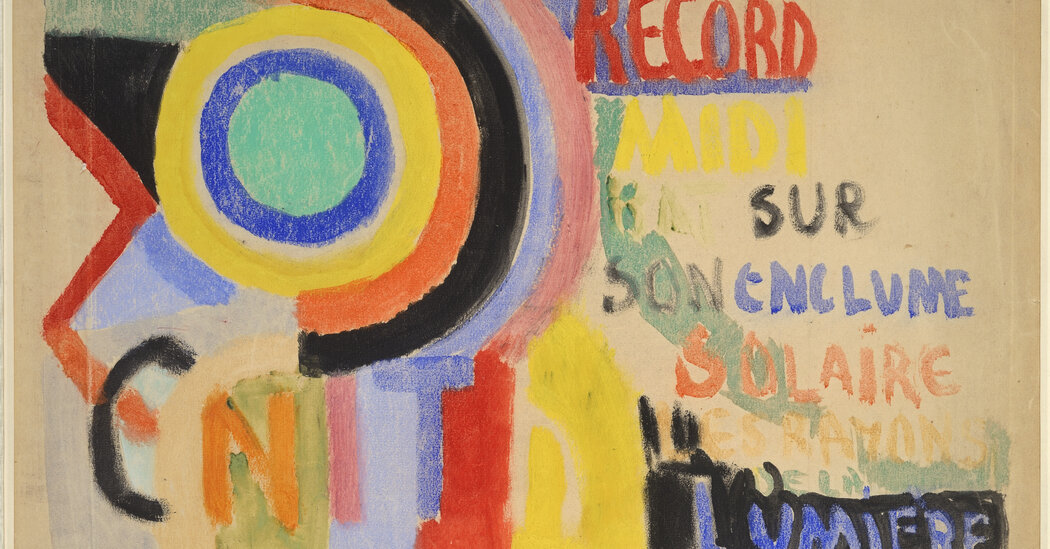In 1930, the Hungarian artist Laszlo Moholy-Nagy made a kinetic sculpture, titled “Light Prop for an Electric Stage (Light-Space Modulator),” from metal, plastics and wood, and fitted it with an electric motor. He knew what would happen when he turned it on. And yet, as he later wrote in the 1947 revised edition of his 1928 book, “The New Vision,” seeing it in motion for the first time made him feel “like the sorcerer’s apprentice.”
“The mobile was so startling in its coordinated motions and space articulations of light and shadow sequences,” he wrote, “that I almost believed in magic.”
Three presentations at Art Basel Paris, open to the public from Friday to Sunday, focus on such moments of experimental discovery, radical redefinition of art and an expansion of the mind.
Modernist Movements
The Paris Galerie Le Minotaure will present a group show, “From the Section d’Or to Dimensionism.” It draws a lineage between the Section d’Or (the 1910s Cubist group formed by Fernand Léger, Robert Delaunay, Francis Picabia and Marcel Duchamp, among others, that took its name from the golden ratio) and Charles Sirato’s 1936 Dimensionist manifesto.
Sirato’s manifesto, the Le Minotaure owner Benoit Sapiro said in a phone interview, was co-signed by some of the era’s most important artists, including Picabia, Duchamp, Moholy-Nagy, Wassily Kandinsky, Alexander Calder, and Delaunay and Sonia Delaunay. In it, Sirato declared that, in the age of Einsteinian physics, all traditional boundaries between the arts were exploded. He wrote about literature “leaving the line,” painting “entering space,” and sculpture being “motorized” and, ultimately, “vaporized.”
“Instead of looking at objects of art,” Sirato wrote, “the person becomes the center and the subject of creation, and creation consists of sensorial effects operating in a closed cosmic space.”
Two works by Léger will bookend the show, which will also feature one of Sirato’s “Poèmes planistes” and several of Sonia Delaunay’s Simultanist works, including “Zénith Etude,” from 1914.
Two pieces by Moholy-Nagy, including “Space Modulator” (1943-45), will showcase the artist’s experimentation with new materials. In Germany, he favored early plastics, including galalith, and trolit. When he moved to the United States in 1937, he began working with second-generation Plexiglas. Where Naum Gabo’s early Plexiglas works have now all but disintegrated, Sapiro said, Moholy-Nagy’s are “in perfect condition; they have not budged.”
“Each new venture led him on a quest for something to take him over the edge,” Sapiro said.
Capturing the “Uncapturable”
At the Grand Palais, Kadel Willborn gallery, based in Düsseldorf, Germany, will present “A Curated Dialogue Between Liz Deschenes (US 1966) and Lucia Moholy (HUN/AT1894-1989).”
From 1923 to 1928, Lucia Moholy worked as a photographer alongside her then-husband, Moholy-Nagy, at the Bauhaus school in Dessau, Germany, where Moholy-Nagy taught. She conducted photographic experiments with him and documented Bauhaus architectural and product designs, a de facto role for which she long went unpaid and uncredited.
The New York-based contemporary photographer Liz Deschenes will exhibit a new free-standing photographic sculpture, “Untitled,” made in response to Moholy’s works. Created with two large, reflective black prints mounted back to back in a white frame and tilted at a slant, the piece references how Moholy tilted the lens in her large-format camera to change perspective.
“I’m really interested in how the movements of the camera, or behind the camera, or in the camera get sort of translated to the viewer,” Deschenes said in a phone interview. “The hope is that a viewer may feel an expanse.” Of Moholy, she said that “her understanding of photography is expansive.”
There will be 10 original prints by Moholy, which she took at the Bauhaus in Dessau before she and Moholy-Nagy left in 1928. On one level, they are documentary: Each title, like “Bauhaus Weimar, Children‘s Room by Alma Buscher,” describes the object of the shoot — in this case, a bedroom set.
But in her compositional choices, Deschenes said, Moholy also “obliterates information.” In “Staircase at the Bauhaus Weimar With Wall Design by Herbert Bayer” (1923), she uses light and shadow in a way that not only hides details from the viewer, but also captures the atmosphere of the space. She managed to “capture what’s usually the uncapturable, photographically,” Deschenes said.
In her 1939 book “A Hundred Years of Photography,” Moholy wrote, “Life without photographs is no longer imaginable,” adding, “They pass before our eyes and awaken our interest; they pass through the atmosphere, unseen and unheard, over distances of thousands of miles.”
Inside an Artist’s Mind
At the fair, the Paris gallery Martine Aboucaya will highlight not merely the uncapturable, but the entirely immaterial, with five seminal works by the American Conceptual artist Robert Barry.
In a phone interview, the curator Mathieu Copeland said the show’s title, “1969,” refers to “a year of radical works” where Barry achieved a “complete reduction” — a “vaporization,” as Sirato might have said — of his process. In place of paint on canvas, Barry used magnetism, inert gas, radiation, telepathy and the psyche.
“I always said the most important space in art is between the viewer and the work itself on the wall,” Barry said in a phone interview.
Barry turns 90 in March and can no longer travel, so Copeland arranged the works on his behalf. Throughout the fair, the gallery’s booth will appear empty, save for free postcards showcasing each day’s action.
For “Radiation Piece,” Copeland said, Barry originally buried four small vials of the radioactive isotope barium-133 in Central Park, in New York, in January 1969 (it is unknown if they are still there). To restage this within current safety parameters, the gallery sourced a small piece of torbernite, a mineral prized for its mild radioactivity, which Copeland buried in the Parc de la Villette, in Paris, for several minutes on Sept. 22 before removing it.
For Barry’s “Inert Gas Series,” the restaging involved releasing helium in the Camargue, in southern France, this summer. And on Friday, a hidden battery-powered transmitter will be installed in the booth to recreate Barry’s “Expanding Electromagnetic Energy Field.” Copeland thinks the idea is beautiful, he said, because “you cannot see it, touch it, feel it, but it’s there.”
For the “Telepathic Piece,” on Saturday at an unspecified time, Barry will telepathically transmit a work of art. Sunday will focus on his “Psychic Series.” Originally “shown” by being published in a 1969 exhibition catalog, it is effectively contained within a sentence: “Everything in the unconscious perceived by the senses but not noted by the conscious mind during trips to Baltimore during the summer of 1967.”
Sirato would approve: no objects of art to see here, just the cosmic space of an artist’s mind.
The post At Art Basel Paris, Experimentalists and Their Big Ideas Are Celebrated appeared first on New York Times.




